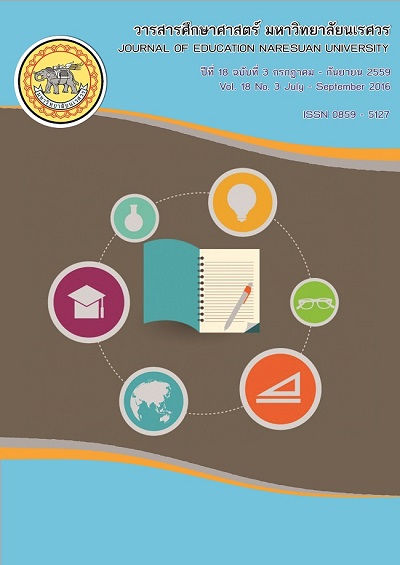การพัฒนาแบบวัดความถนัดทางการเรียนวิทยาศาสตร์การกีฬา ของนักศึกษาระดับปริญญาตรี
Main Article Content
Abstract
การวิจัยครั้งนี้มีวัตถุประสงค์เพื่อพัฒนาแบบวัดความถนัดทางการเรียนวิทยาศาสตร์การกีฬาของนักศึกษาระดับปริญญาตรี โดยมีวัตถุประสงค์เฉพาะ 4 ประการ คือ 1) เพื่อศึกษาองค์ประกอบและความสัมพันธ์ขององค์ประกอบความถนัดทางการเรียนวิทยาศาสตร์การกีฬา 2) เพื่อสร้างแบบวัดความถนัดทางการเรียนวิทยาศาสตร์การกีฬาของนักศึกษาระดับปริญญาตรี 3) เพื่อตรวจสอบคุณภาพของแบบวัดความถนัดทางการเรียนวิทยาศาสตร์การกีฬาของนักศึกษาระดับปริญญาตรี และ 4) เพื่อสร้างเกณฑ์ปกติของแบบวัดความถนัดทางการเรียนวิทยาศาสตร์การกีฬาของนักศึกษาระดับปริญญาตรี กลุ่มตัวอย่างคือ ผู้เชี่ยวชาญด้านวิทยาศาสตร์การกีฬา 9 ท่าน ได้มาโดยการเลือกแบบเจาะจงและนักศึกษาระดับปริญญาตรี ชั้นปีที่ 3 สาขาวิทยาศาสตร์การกีฬา ปีการศึกษา 2557 จำนวน 945 คน ได้มาโดยวิธีการสุ่มแบบชั้นภูมิ ผลการวิจัย พบว่า
1. ความถนัดทางการเรียนวิทยาศาสตร์การกีฬาประกอบด้วย 7 องค์ประกอบ คือ คณิตศาสตร์ ภาษา เหตุผล มิติสัมพันธ์ การคิดวิเคราะห์ การจัดการ และมนุษยสัมพันธ์ และองค์ประกอบมีความสัมพันธ์กันดังนี้ คณิตศาสตร์-เหตุผล เหตุผล-มิติสัมพันธ์ คณิตศาสตร์-มิติสัมพันธ์ ภาษา-มิติสัมพันธ์ การจัดการ-มนุษยสัมพันธ์ เหตุผล-การคิดวิเคราะห์ เหตุผล-การจัดการ มิติสัมพันธ์-การคิดวิเคราะห์ ภาษา-การจัดการ มิติสัมพันธ์-มนุษยสัมพันธ์ และภาษา-มนุษยสัมพันธ์
2. ลักษณะของแบบวัดความถนัดที่สร้างขึ้นเป็นแบบเลือกตอบ 4 ตัวเลือก จำนวน 86 ข้อ แยกเป็น 7 ชุด ตามองค์ประกอบ ได้แก่ คณิตศาสตร์ ภาษา เหตุผล การคิดวิเคราะห์ การจัดการ และมนุษยสัมพันธ์ ด้านละ 12 ข้อ และด้านมิติสัมพันธ์ 14 ข้อ
3. คุณภาพของแบบวัดความถนัดทางการเรียนวิทยาศาสตร์การกีฬา มีดังนี้
3.1 คุณภาพรายข้อ ได้แก่ 1) ความตรงตามเนื้อหา มีค่าดัชนีความสอดคล้องของข้อคำถามกับนิยามความถนัดทางการเรียนวิทยาศาสตร์การกีฬามีค่าตั้งแต่ 0.6 – 1.0 2) ความยากง่าย มีค่าตั้งแต่ 0.23 –0.79
3) อำนาจจำแนก มีค่าตั้งแต่ 0.29 – 0.83
3.2 คุณภาพรายฉบับ ได้แก่ 1) ความตรงตามสภาพ มีค่าสัมประสิทธิ์สหสัมพันธ์แบบเพียร์สันระหว่างคะแนนความถนัดทางการเรียนวิทยาศาสตร์การกีฬากับเกรดเฉลี่ยสะสม เท่ากับ 0.655 อย่างมีนัยสำคัญทางสถิติที่ระดับ .01 2) ความตรงตามโครงสร้าง โดยการวิเคราะห์องค์ประกอบเชิงยืนยัน พบว่า โมเดลโครงสร้างของแบบวัดมีความสอดคล้องกลมกลืนกับข้อมูลเชิงประจักษ์ โดยค่าไคสแควร์ที่องศาอิสระ 3558 มีค่า 3031.83 p = 1.00 ค่าดัชนีวัดระดับความกลมกลืน 0.84 ค่าดัชนีวัดระดับความกลมกลืนที่ปรับแก้แล้ว 0.83 ค่าดัชนีรากกำลังสองเฉลี่ยของเศษเหลือในรูปคะแนนมาตรฐาน 0.072 และค่ารากของค่าเฉลี่ยกำลังสองของความคลาดเคลื่อนโดยประมาณ 0.00 อย่างมีนัยสำคัญทางสถิติ และ 3) ความเที่ยงรายฉบับ มีค่าประสิทธิ์แอลฟา 0.902 โดยแบบวัดด้านภาษามีค่าความเที่ยงสูงสุด (.809) ด้านมิติสัมพันธ์ (.793) ด้านมนุษยสัมพันธ์ (.762) ด้านคณิตศาสตร์ (.758) ด้านเหตุผล (.753) ด้านการจัดการ (.596) และด้านการคิดวิเคราะห์ (.590)
4. เกณฑ์ปกติของแบบวัดความถนัดทางการเรียนวิทยาศาสตร์การกีฬา แบ่งเป็น 5 ระดับ ได้แก่ T 66 ขั้นไปอยู่ระดับสูงมาก T55-T66 อยู่ระดับสูง T45-T54 อยู่ระดับปานกลาง T33-T43 อยู่ระดับต่ำ และต่ำกว่า T32 อยู่ระดับต่ำมาก พบว่า 1) ภาพรวมมีคะแนนมาตรฐานทีปกติตั้งแต่ T23 –T79 และ 2) แยกตามองค์ประกอบคือแบบวัดด้านคณิตศาสตร์มี T27–T67 ภาษามี T21–T64 เหตุผลมี T21–T66 มิติสัมพันธ์มี T21–T75 การคิดวิเคราะห์มี T26–T73 การจัดการมี T26–T74 มนุษย-สัมพันธ์มี T23–T79
A DEVELOPMENT OF SPORTS SCIENCE SCHOLASTIC APTITUDE TESTS FOR BACHELOR’S DEGREE STUDENTS
The purpose of this research was to develop the sport science scholastic aptitude tests for bachelor’s degree students. The four specific objectives were 1) to study factors and relationship among factors of sport science scholastic aptitude, 2) to develop sport science scholastic aptitude tests for bachelor’s degree students, 3) to validate the sport science scholastic aptitude tests, and 4) to develop norms of the scholastic aptitude tests for bachelor’s degree students. The sample group one was nine professionals in sport science selected by purposive sampling and group two was 945 had students in third year level in majoring sport science in academic year 2014 by proportionate stratified random sampling. Research conclusions were fallow:
1. There were seven factors for sport science scholastic aptitude test as numerical, verbal, reasoning, spatial relationships, critical thinking, management and relationship. Relation among factors were numerical-reasoning, reasoning-spatial relationship, numerical-spatial relationship, verbal-spatial relationship, management-relationship, reasoning-critical thinking, reasoning-management, spatial relationship-critical thinking, verbal - management, spatial relationship-relationship, verbal- relationship.
2. The kind of sport science scholastic aptitude tests was a 4 multiple choices test, There was one answer in 4 choices. Give 1 score if collect, give 0 score if wrong. There were eighty-six items in the sport science scholastic aptitude test. Most items covered the definition and structure of seven factors. Six factors had 12 items: numerical, verbal, reasoning, critical thinking, management and relationship. Spatial relationship had 14 items
3. Quality of sport science scholastic aptitude tests were as follow:
3.1 Items quality: 1) Content validity by item objective congruence index (IOC) had 0.6 – 1.0. 2) Level of difficulty had 0.23 – 0.79. 3) Power of discrimination had 0.29 - 0.83.
3.2 Tests quality: 1) Concurrent validity by Pearson’s product moment between sport science scholastic aptitude scores and grade point average, were statistical significance at .01 level. 2) Construct validity by confirmatory factor analysis (CFA), structure model was fit with empirical data. There were Chi-Square () = 3031.83 p = 1.00 df = 3558, GFI = 0.84, AGFI = 0.83, Standardized RMR = 0.072 and RMSEA = 0.0 and there were statistical significance. 3) Reliability by alpha coefficient (); total=0.902 and order were verbal = 0.809, spatial relationships = 0.793, relationship = 0.762, numerical = 0.758, reasoning = 0.763, management = -0.596 and critical thinking = 0.590
4. Norms of sport science scholastic aptitude scores were 5 level: T66 and higher as very high or excellent, T55-T65 as high, T44-T54 as moderate, T33-T43 as low and T32 and lower as very low 1) Total norms had T23-T75, and 2) Divide to factors: numerical = T27-T67, verbal = T21-T64, reasoning = T21-T66, spatial relationship = T21-T75, critical thinking = T26-T73, management = T26-T74 and relationship = T23-T79
Article Details
The owner of the article does not copy or violate any of its copyright. If any copyright infringement occurs or prosecution, in any case, the Editorial Board is not involved in all the rights to the owner of the article to be performed.


